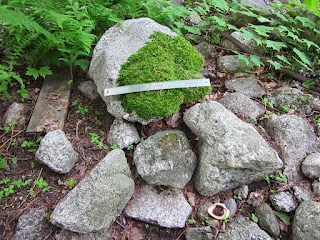Rock Art
Specialist Edward J. Lenik writes: “The turtle motif occurs on numerous
portable artifacts and petroglyph sites in the Northeast…Turtle images appear
in several artistic media…stone, clay, bone, shell, wood, antler, and in
Historic Contact times as molded lead objects…pendants and gorgets, pebbles,
cobbles, stone tools, clay pipes, and wooden bowls.”
“The
turtle is a sacred animal, an important spirit for Algonkian and Iroquois
peoples (Lenik 2009: 146- 147).”
Edward J. Lenik suggests that the
turtle, in “portable artifacts” and “nonportable petroglyphs,” can be a symbol
of the Earth, the first animal created, the first clan/first people created, a
symbol of longevity, patience, perseverance or fertility (a womb), and if found
as a petroglyph on a boulder or outcrop as perhaps the boundary of a Turtle
Clan territory such as a Village site or Hunting/Gathering Ground, or a
Guardian Spirit of a path or trail. As a stacked stone feature (in “stone prayers”
or “stone walls”), I’m going to take what he says into consideration as a
possibility as to a possible "icon" that suggests Indigenous construction...
A prayer to the Turtle is a prayer to “All
of Creation.” A Stone Prayer constructed to resemble a Turtle is initially a
prayer “spoken into the stone (Harris)” during its construction, but it also becomes
a place to continue to pray by the person who constructed it and perhaps to
that person’s descendants.
I’m biased perhaps because the first stone constructions that seemed to me to be effigies (a bear and a deer head, each on a boulder), also seemed to be places to burn some tobacco, perhaps for hunting purposes (Speck, Tantequidgeon), but also perhaps as a place for a daily prayer or even after a hunt as inferred by the story of Obed’s Altar from the Saybrook area of CT (https://wakinguponturtleisland.blogspot.com/2014/08/up-there-with-bear.html; http://www.dunhamwilcox.net/town_hist/westbrook_hist.htm).
Then again, another name for a Sachem (“Peace
Chief”) is “our bear” or even “our old bear” and “our younger bear,” names for
an elder (perhaps white haired?) sachem and a younger sachem of a Peace (White)
Town as opposed to a War Chief at a Warriors (Red) Town (Driver? Trigger??). Perhaps this bear was
always associated with the Sachem or Sachems, at the “camp” (or Town/Village) referred
in post contact times as Nonnewaug Wigwams near the Fish Weir and planting
fields, perhaps even back to the time there was a glacial lake here…
https://www.worthpoint.com/worthopedia/pipe-bear-head-effigy-jackson-county-1441039424
This is
a hand carved Black Bear effigy pipe bowl from the Chippewa Black Bear Pipe
Effigy. The piece is from circa 1880-1900 and was recovered during extended
field clearance South of Austin Hollow, Kincaid Township, a cache of stone
artifacts was uncovered. This odd bear-head pipe was one of those pieces.
Measures 3"x1.75"x1 5/8"
https://www.icollector.com/Chippewa-Black-Bear-Pipe-Effigy-circa-1880-1900-Th_i21297482
https://dygtyjqp7pi0m.cloudfront.net/i/23095/21297482_1.jpg?v=8D2035AF4269350














Thank you for sharing this.
ReplyDelete